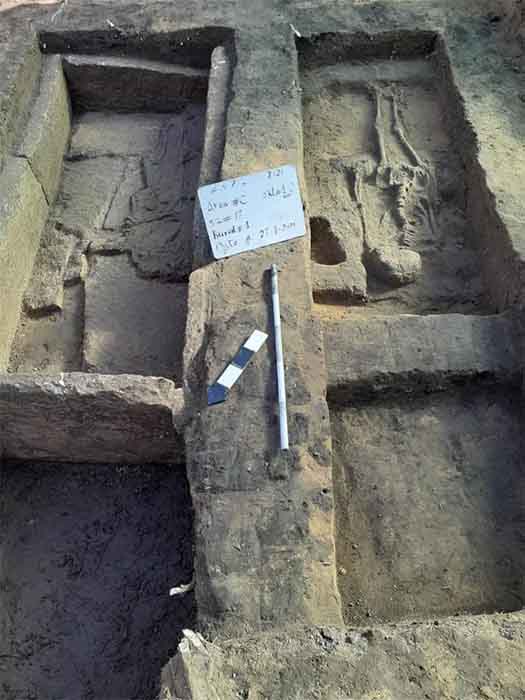
Archaeologists Uncover Preserved Ancient Pottery Workshop in Egypt
Archaeologists digging in the Aziza hills area of the Beheira governate in northern Egypt have recovered the remains a pottery workshop dating to the Graeco-Roman period, Egypt’s Ministry of Tourism and Antiquities announced on its Facebook page on July 6th.
The Graeco-Roman era in Egypt covered the years from approximately 332 BC (when Alexander the Great invaded and conquered the country) to the late fourth century AD. Egypt was ruled by the Greek Ptolemaic Dynasty for the first 300 years of that period. It was taken over by the Roman Empire after that, following Augustus Caesar’s victory over the forces of Cleopatra VII in 30 BC.

Two pieces of pottery found at the preserved pottery workshop site recently found in northern Egypt. (Ministry of Tourism and Antiquities)
Ancient Egyptian Pottery Workshop Practices Revealed
Working under the authority of the Ministry, a team of researchers led by Fayoum University archaeologist Dr. Ibrahim Sobhi uncovered the largely intact workshop while performing excavations at the Tell Kon Aziza site near the village of Abu Hummus in northern Egypt.
This site is located approximately 32 miles (50 kilometers) southeast of Alexandria, and 105 miles (169 kilometers) north of Cairo.
Indications are that settlements existed at this site dating well back into antiquity. Consequently, Ministry archaeologists have been eager to learn more about Tell Kon Aziza’s diverse and complex history.
- Pottery Reveals America's First Social Media
- 4,300-Year-Old First Face Offers a Glimpse of Ancient Japanese Culture
The team was not surprised to find evidence of Graeco-Roman era pottery making. But they were delighted to discover a full pottery workshop that had been so perfectly preserved, virtually in its entirety.
According to Dr. Sobhi, it was possible to trace the process by which raw clay was turned into pottery from the layout of the well-preserved site.
The Ministry’s archaeological mission unearthed the workshop’s mixing area, where clay would be kneaded and combined with other substances to make if more suitable for pottery making. They also found the formation area, where the clay could be shaped into its desired final form. Moreover, they discovered the workshop’s drying area, where the molded clay could be laid out in the sun for de-moisturizing. Topping things off, they found the remains of furnaces where the clay would be fired at high temperatures to convert it into ceramic pottery.
Despite their antiquity, the clay baking ovens were well designed. Dr. Aiman Ashmawi, the head of the Ancient Egyptian Antiquities Sector, explained that the ovens were built from fired bricks and featured powerful updraft kilns. They were surrounded by thick sections of mud bricks, which helped reduce heat pressure generated during the firing process. They had gas supply pipes and pressure valve pipes as well, allowing for even more precise heat control.

A ceramic vase or vessel found at the ancient pottery workshop site in northern Egypt. (Ministry of Tourism and Antiquities)
Searching through the various sections of the workshop, the archaeologists found finished ceramic pieces along with chunks of un-baked molded clay. They found some ancient metal tools that would have been used to cut and shape the clay. Most excitingly, they found the remains of an ancient potter’s wheel. The Egyptian potter’s wheel was widely in use by the mid-third millennium BC, and was likely invented during Egypt’s glorious Old Kingdom period (also known as the Age of the Pyramids).
The statement by the Ministry of Tourism and Antiquities didn’t clarify whether the remnants of finished pottery found at the site showed any signs of Greek or Roman influence. This type of detail would allow the archaeologists to identify the age of the pottery workshop more precisely, since the years of Greek and Roman rule were distinctly separate.
Dr. Mustafa Waziri, Secretary General of Egypt’s Higher Archaeology Council, said that the structures found in the workshop date it to sometime between the third century BC and the first century AD. This broad dating range leaves open the possibility that it might have been constructed during either the Greek or Roman half of the Graeco-Roman era.

The remains of two people in mudbrick burials from an earlier period, which were found beneath the pottery workshop site. (Ministry of Tourism and Antiquities)
An Ancient Egyptian Time Capsule: Uncovering 5,000 Years of History
Digging down to deeper levels, the archaeologists also found artifacts and structures left by more ancient occupants of the Aziza hills site—some of whom were actually buried there.
- Development of Advanced Pottery by “Barbarians” Found in Poland
- 1,600-Year-Old Pottery Workshop Has First Known Rock-Hewn Kiln in Israel
“The team discovered an Early Dynastic settlement that contains mud brick houses with pottery inside for daily use, cooking ovens and storage magazines as well as bronze coins,” Dr. Sobhi said in the Ministry press release. Further down, they excavated “a number of mud brick burials [that] contain some skeletons buried in the squatting position and covered with a thick mud layer and surrounded with pottery and alabaster funerary jars.”
Egypt’s Early Dynastic period lasted from approximately 3,150 BC to 2686 BC. This is the time when Egypt’s First and Second Dynasties ruled over a newly unified Egypt. It was during this vital period that Egypt completed its transition from a land of isolated villages to a powerful bureaucratic state, setting the stage for more spectacular future periods when Ancient Egypt would reach the height of its power.
If the archaeological team’s conclusions are accurate, the Tell Kon Aziza site may have been occupied as long as 5,000 years ago, and continuously after that. It remains to be seen if additional excavations might produce artifacts that push this timeline back even further.
Top image: The largely intact, preserved pottery workshop recently unearthed in northern Egypt, dating from the Graeco-Roman period. Source: Ministry of Tourism and Antiquities
By Nathan Falde















